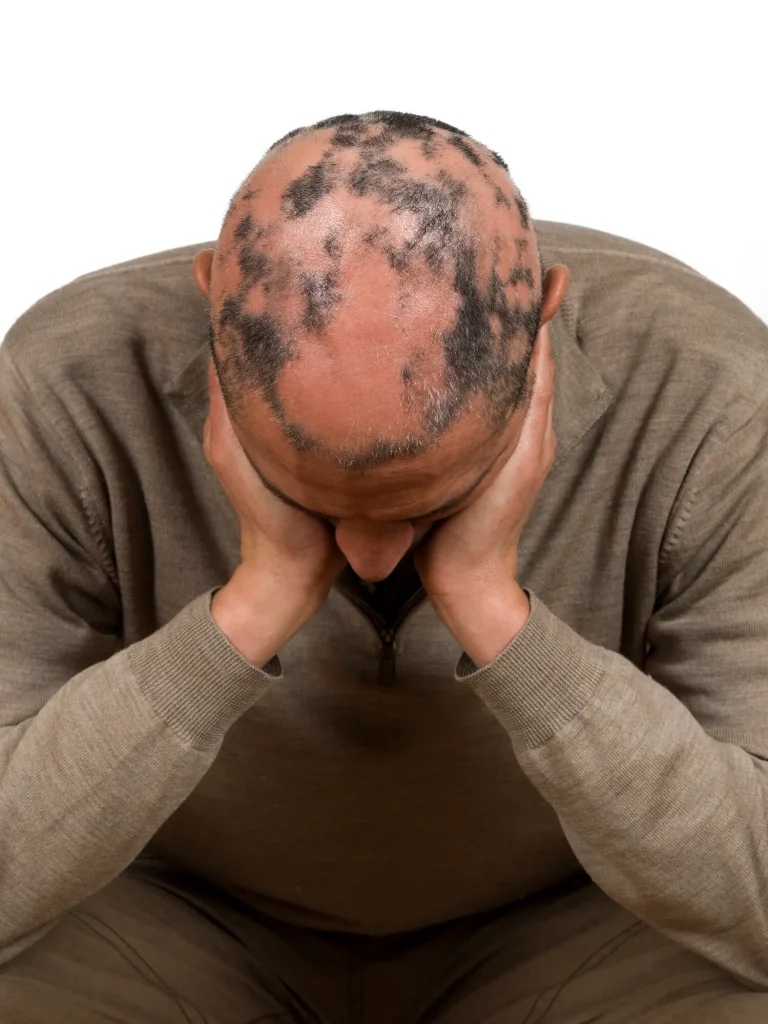Alopecia Areata
Our dermatologists at MetaDerm are highly qualified and well-experienced in handling different types of alopecia areata. We have helped many patients regrow hair even after alopecia totalis.
One of the most common causes of non-scarring hair loss is Alopecia areata. MetaDerm has expertise in managing all types of hair loss, including Alopecia Areata. Anti-inflammatory injections can be highly effective in treating this type of hair loss and may even lead to hair regrowth in many cases.

Key Highlights:
- Alopecia Areata is one of the most common types of hair loss disorders
- Starts with a small area of focal hair loss.
- Scalp hair is the most affected, followed by beard, eyebrows, and lashes.
- Alopecia affects both adults and children.
- In most cases, simple treatments will suffice.
- Alopecia, including complex cases, can be handled by dermatologists.
Our results speak for themselves






Alopecia Areata at a glance
- Best outcomes: variable
- Procedure time: 10 mins
- Duration of results: can be permanent
- Back to work: Immediately
- Recovery: NA
- Anaesthetic: injections
- Your specialist: Dermatologist
- How much: ₹
Frequently Asked Questions
Alopecia areata is a very common scalp disorder that causes hair loss in both men and women, adults and children. The different types of Alopecia Areata are:
Patchy alopecia areata:
This is the most common type of Alopecia areata that can cause hair loss in one or more coin-sized patches on the scalp or body. These patches can expand and convert into alopecia totalis or alopecia universalis.
Alopecia totalis:
In this type of Alopecia, the hair loss occurs throughout the scalp. Alopecia totalis accounts for close to 5% of autoimmune hair loss.
Alopecia universalis:
In this type, in addition to the scalp, hair loss will occur on the face, eyelashes, and eyebrows. Some may even lose their pubic, chest, and back hair. Alopecia universalis is very rare and accounts for less than 1% of autoimmune hair loss.
Diffuse alopecia areata:
This type of alopecia causes hair all over the scalp to start thinning suddenly. The newly growing hair will grey easily and is commonly described as turning white overnight. It can also be confused with other clinical conditions.
Ophiasis:
This type of alopecia areata affects the lateral side and the back of the scalp. When hair starts falling, the bald area can form a circle around the scalp.
Alopecia areata of the nails:
10-50% of those suffering from Alopecia Areata can experience ridging or tiny depressions in the nails known as pitting.
MetaDerm offers the best alopecia treatment in Chennai. We diagnose Alopecia areata after a thorough examination of the hair loss patches. Apart from considering your medical and family history, we will also conduct a simple hair-pull test to understand the severity of the hair loss. We also use trichoscopy to examine your hair and scalp before confirming a diagnosis.
Alopecia Areata has a distinct characteristic known as exclamation mark hairs that can be missed by the untrained eye. These hairs come with a club-shaped root, 2 or 3 mm in length, and are either broken or tapered. We may perform a biopsy of these hairs to rule out other conditions or perform additional blood tests if we suspect an autoimmune condition.
In most cases, Alopecia areata will resolve itself, and hair regrows spontaneously. Dermatologists can speed up this process with the use of topical or intralesional anti-inflammatory medications, which are mostly just different forms of steroids.
At MetaDerm, we focus on holistic hair care and treat alopecia areata in the following ways:
- Apply topical agents like minoxidil, Anthralin, or topical steroids to the affected areas to stimulate hair growth.
- Inject steroids through tiny needles, every one or two months. This can only stimulate hair growth and does not prevent any hair loss.
Alopecia areata is an autoimmune condition that causes hair loss. So, the immune system, instead of protecting the body, attacks the growing hair. The exact cause of this condition is still unknown. However, the following can trigger the immune response:
- Viral infections
- Trauma to the affected area
- Changes in hormone levels
- Stress – physical or emotional
- Pre-existing autoimmune conditions like type 1 diabetes
- History of alopecia in the family

